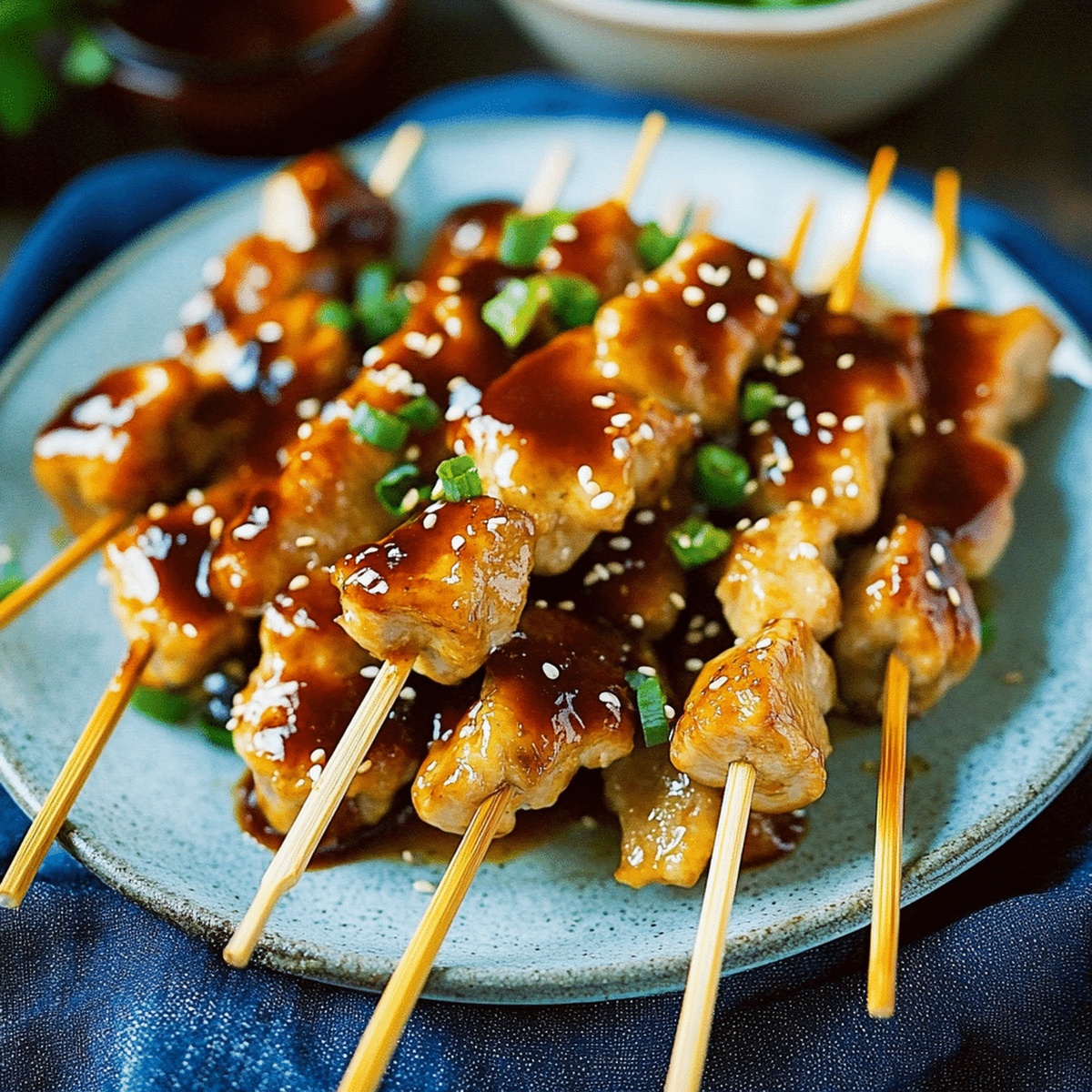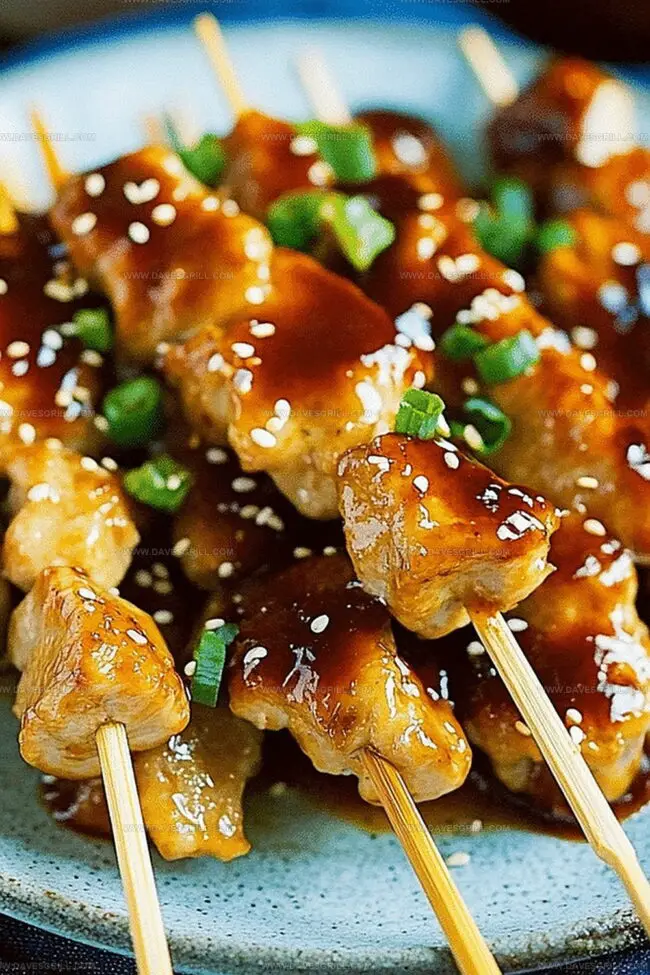Grilled Goodness: Tantalizing Smoky Yakitori Recipe
Grilling chicken skewers with a smoky yakitori sauce brings intense flavors that dance across your palate.
Japanese street food culture breathes life into this simple yet remarkable dish.
The sizzling meat caramelizes beautifully over hot charcoal, creating an irresistible aroma.
Yakitori represents more than just a meal – it’s a culinary tradition steeped in precision and passion.
Each tender chicken piece gets brushed with a deeply savory glaze that transforms ordinary ingredients into something extraordinary.
Skewers loaded with succulent meat promise a delightful journey through authentic Japanese cuisine.
You won’t be able to resist these perfectly grilled morsels that capture the essence of Tokyo’s vibrant food scene.
Quick Recipe Overview
Yakitori Ingredients List for Grilled Perfection
For Sauce Base:For Aromatic Enhancers:For Protein Companion:Tools for Making Authentic Yakitori
Easy Grilling Instructions for Yakitori Skewers
Toss all sauce ingredients into a compact pan and get ready to create with soy sauce, mirin, sake, sugar, garlic, and ginger.
Crank up the heat until the mixture bubbles, then dial it down and let the flavors dance together for 10-15 minutes, stirring occasionally until the sauce starts to thicken like liquid gold.
Pull the pan off the heat and strain out the chunky bits, leaving behind a silky-smooth sauce that’s packed with incredible taste. Let it chill and mellow out while you prep the rest of your yakitori.
Thread your favorite chicken pieces onto wooden skewers, making sure each piece is snug and secure.
Fire up the grill or grill pan to medium-high heat. Lay those skewers down and cook, turning and basting with your carefully crafted sauce until the chicken is beautifully caramelized and cooked through.
In the final moments of grilling, brush on extra sauce to create an irresistible glossy finish. Transfer to a serving plate and get ready to enjoy some seriously delicious yakitori.
Flavor Tips to Perfect Your Yakitori
How to Present and Serve Yakitori Skewers
Store and Reheat Yakitori for Later Bites
FAQs
Yakitori sauce, also known as tare, combines soy sauce, mirin, sake, sugar, garlic, and ginger, creating a sweet and savory glaze that gives the grilled chicken its signature rich flavor.
Yes, you can prepare the sauce in advance and store it in an airtight container in the refrigerator for up to a week. The flavors will continue to develop and become more intense over time.
While traditionally used for chicken skewers, this versatile sauce works wonderfully with other proteins like beef, pork, and even vegetables, adding a delicious Japanese-style glaze to your grilled dishes.
The sauce is done when it reduces and slightly thickens, coating the back of a spoon. It should have a glossy, syrupy consistency that will caramelize beautifully when brushed on grilled meats.
Print
Smoky Yakitori Recipe
- Total Time: 35 minutes
- Yield: 5 1x
Description
Succulent yakitori skewers from Japan blend tender chicken pieces with a glossy, umami-rich tare sauce that elevates grilling traditions. Charcoal-kissed meats and precise seasoning invite diners to savor authentic street-food flavors.
Ingredients
- 1 lb (454 g) chicken thighs, boneless and skinless, cut into bite-sized pieces
- ½ cup (120 ml) soy sauce
- ½ cup (120 ml) mirin
- ¼ cup (60 ml) sake
- 2 tbsps sugar
- 4–6 green onions (scallions), cut into 2-inch pieces
- 2 garlic cloves, minced
- 1-inch piece ginger, sliced
- bamboo skewers (soaked in water for 30 minutes)
Instructions
- Glaze Preparation: Combine soy sauce, mirin, sake, sugar, minced garlic, and grated ginger in a saucepan, creating a flavor-packed base for the yakitori sauce.
- Sauce Reduction: Bring the mixture to a vigorous boil, then immediately lower heat to a gentle simmer. Allow the liquid to reduce and concentrate, stirring occasionally to prevent burning and develop a rich, glossy texture over 10-15 minutes.
- Refinement: Strain the glaze through a fine-mesh sieve, eliminating garlic and ginger solids while preserving the smooth, intense sauce. Let the glaze cool to room temperature, allowing its flavors to meld and slightly thicken.
- Final Touch: The resulting glaze will transform your grilled proteins with a luxurious coating that captures the quintessential sweet, salty, and umami essence of authentic Japanese yakitori.
Notes
- Manage Heat Carefully: Control simmering temperature to prevent burning or over-reducing the glaze, which can make the sauce bitter and lose its delicate flavor balance.
- Strain for Smoothness: Use a fine-mesh sieve to remove garlic and ginger solids, ensuring a silky, professional-quality sauce with pure, clean flavors.
- Monitor Glaze Consistency: Watch the sauce thicken gradually; it should coat the back of a spoon without being too runny or overly sticky for optimal glazing.
- Rest and Develop Flavor: Let the glaze cool at room temperature to allow natural flavor concentration and achieve a more complex, rounded taste profile.
- Prep Time: 15 minutes
- Cook Time: 20 minutes
- Category: Dinner, Appetizer, Snacks
- Method: Simmering
- Cuisine: Japanese
Nutrition
- Serving Size: 5
- Calories: 360
- Sugar: 6 g
- Sodium: 980 mg
- Fat: 15 g
- Saturated Fat: 4 g
- Unsaturated Fat: 8 g
- Trans Fat: 0 g
- Carbohydrates: 25 g
- Fiber: 1 g
- Protein: 30 g
- Cholesterol: 100 mg




Emily Lawson
Content Creator & Culinary Specialist
Expertise
Education
Oregon Culinary Institute
Diploma in Culinary Arts
Focus: Emphasis on farm-to-table cooking, sustainable practices, and the fusion of global flavors with traditional grilling methods.
Emily Lawson is the content creator at Daves Grill, turning tasty ideas into clear, easy recipes. Based in Portland, she trained at the Oregon Culinary Institute and loves cooking with fresh, seasonal ingredients, especially grilled veggies and global flavors.
Emily mixes food writing with hands-on cooking to bring you recipes that feel fun, not stressful. Her goal is to make every dish simple, flavorful, and worth coming back to. Together, she and Dave serve up real food, one recipe at a time.